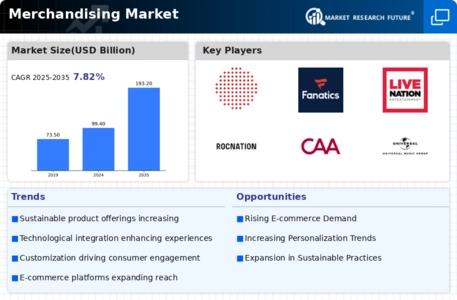E-commerce Growth
The rapid expansion of e-commerce is a critical driver of the Global Merchandising Market Industry. With more consumers opting for online shopping, retailers are compelled to enhance their merchandising strategies to capture this growing segment. The convenience of online platforms allows for a broader reach, enabling businesses to showcase their products to a global audience. As a result, the industry is likely to witness a compound annual growth rate of 6.23% from 2025 to 2035. This growth reflects the necessity for retailers to invest in effective online merchandising techniques, ensuring that they meet the expectations of tech-savvy consumers.
Sustainability Trends
Sustainability trends are increasingly influencing the Global Merchandising Market Industry, as consumers become more environmentally conscious. Retailers are responding by incorporating sustainable practices into their merchandising strategies, such as sourcing eco-friendly materials and promoting ethical production methods. This shift not only meets consumer demand but also enhances brand loyalty and reputation. As sustainability becomes a core value for many consumers, the industry is likely to adapt, leading to innovative merchandising solutions that align with these principles. This focus on sustainability may further drive market growth, as businesses that prioritize environmental responsibility are likely to attract a larger customer base.
Rising Consumer Demand
The Global Merchandising Market Industry experiences a notable surge in consumer demand, driven by evolving preferences for personalized and unique products. As consumers increasingly seek distinctive items that reflect their individuality, retailers are adapting their merchandising strategies to cater to this trend. This shift is evident in the projected market value of 99.4 USD Billion in 2024, indicating a robust growth trajectory. Retailers are leveraging data analytics to understand consumer behavior better, allowing them to curate offerings that resonate with target audiences. This heightened focus on consumer-centric merchandising is likely to propel the industry forward, fostering innovation and creativity.
Globalization of Brands
The globalization of brands significantly impacts the Global Merchandising Market Industry, as companies expand their reach into international markets. This trend necessitates the adaptation of merchandising strategies to cater to diverse cultural preferences and consumer behaviors. Brands that successfully navigate these complexities are likely to thrive in the competitive landscape. The increasing interconnectedness of markets presents opportunities for growth, with projections indicating a substantial increase in market value over the coming years. As brands continue to globalize, the industry may witness innovative merchandising approaches that resonate with a broader audience, enhancing overall market dynamics.
Market Growth Projections
The Global Merchandising Market Industry is poised for substantial growth, with projections indicating a market value of 99.4 USD Billion in 2024 and an anticipated increase to 193.2 USD Billion by 2035. This trajectory suggests a robust expansion, driven by various factors such as rising consumer demand, technological advancements, and the growth of e-commerce. The compound annual growth rate of 6.23% from 2025 to 2035 further underscores the industry's potential. As businesses adapt to changing consumer preferences and leverage innovative merchandising strategies, the market is likely to evolve, presenting new opportunities for stakeholders.
Technological Advancements
Technological advancements play a pivotal role in shaping the Global Merchandising Market Industry. The integration of artificial intelligence and machine learning into merchandising strategies enhances inventory management and customer engagement. For instance, retailers utilize predictive analytics to forecast trends and optimize stock levels, thereby minimizing waste and maximizing sales potential. As technology continues to evolve, it is expected that the market will expand significantly, with projections indicating a value of 193.2 USD Billion by 2035. This growth underscores the importance of adopting cutting-edge technologies to remain competitive in an increasingly digital landscape.
















